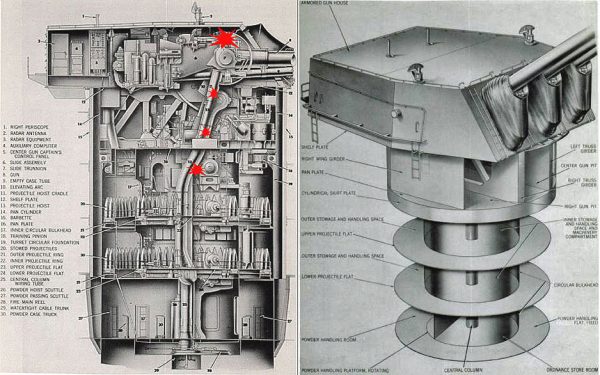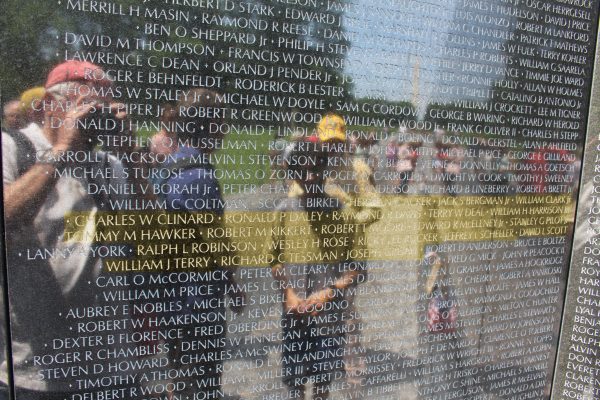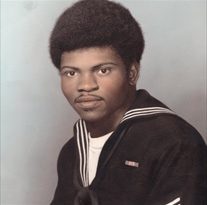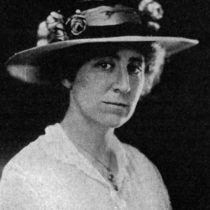I ended my first post sitting on a step Christmas Eve 1972 in Norfolk Navy Yard. In the back of my mind I was wondering how the U S Navy could send a shell which killed twenty sailors and could well have sunk the ship.
Out of the fog came a young sailor, just out of boot camp. He was on base prior to be given an assignment. He said Christmas had become over commercialized, forgot the birth of Christ, and did I know the Lord. I said I had just come back from Vietnam. He went away.
This was when I discovered that there was one good thing I got from my Vietnam experience. For the next thirty years whenever I found myself in a conversation I didn’t want to be in I could just say “I was in Vietnam.” It is so much more dignified than blowing snot in your palm and wiping it on your pants.
 I did however want to know why Turret 2 exploded. After working in a mine and going back to college I got a job working in procurement for the Defense Department. In my interview I did say I wanted to know how such a thing could happen. It helped to get the job.
I did however want to know why Turret 2 exploded. After working in a mine and going back to college I got a job working in procurement for the Defense Department. In my interview I did say I wanted to know how such a thing could happen. It helped to get the job.
Over the years I read all I could, put in some Freedom of Information Requests, researched at the National Archives and wrote both Senator Toomey and Senator Casey a letter asking for information concerning the explosion on board the USS Newport News. (Neither replied)
Early in my career in Defense Department procurement I requested a copy of the as yet unreleased accident report. I was questioned as to why I wanted it and asked “There were a bunch of court martials about on the ship weren’t there? More on that later.
Twenty dead would have been a good day 1967 through 1969, but in 1972 it was the second worst day of the year. The worst was May 10th when a Chinook taking a load of troops to in country R&R came apart In the air. The average US deaths in 1972 was 1.6 a day. The Newport News had 40% of the enlisted casualties in the Navy that year.
There had never been an in barrel high order projectile explosion for 8 inch ammunition in the US Navy. The shell detonated less than a millisecond after the gun fired. The projectile fuze was sent to the ship armed. Additionally the .01 second delay pellet in the fuze was omitted which would have prevented the shell from exploding in the barrel. From the formal investigation report:
56. This casualty resulted from a high order projectile detonation which occurred within a fraction of a millisecond after propellant charge ignition in normal gun firing sequence. The detonation was caused by premature firing of the ADF Mk 55-0, which in turn resulted from the fuze rotor being in the armed position at the instant of gun firing.
57. The ADF concerned was manufactured by Bermite Powder Company in 1968 or 1969. Its design is adequate. Its premature functioning reflects faulty manufacture, including manufacturer’s quality control, and ineffective government inspection by DCAS, in response to inadequate criteria specified by NAVORDSYSCOM.
An explosion in the main armament of a gun ship can reasonably be expected to sink the ship. That would have required more panels in the Vietnam Wall.
48. When filled, NEWPORT NEWS 8” powder hoists constitute vulnerable and dangerous paths for the propagation of high-energy flame direct from the gun chamber to the powder handling room, at magazine level below the armor deck. Nearly a ton of powder could become involved in the hoists of each turret. The initiating flame could originate either with a casualty, as in this instance, or by enemy action. There is an automatically-actuated sprinkling system in these turrets which includes branches inside the powder hoists. Apparently the system actuated as intended in this casualty. But such systems do not have the capacity to extinguish powder fires once started, and because of both limited capacity and relatively slow response times, we would not judge that the hoist sprinklers were or could be factors in preventing flame propagation in the hoists under circumstances such as found in this case. The loading scuttles at the lower ends of the hoists would provide no protection from further flame propagation if the hoists themselves ruptured within the handling room, as they did in this casualty in the spaces above the handling room.
49. Thus one can only speculate on how close this casualty came to extending into a magazine. If it did, survival of the ship itself would be speculative. The powder hoists should be modified to incorporate at least one flame barrier in each hoist, perhaps at the pan plate level. As a minimum safety factor this barrier should open automatically for each hoist movement, but remain closed during the hoist’s stationary intervals.
It’s always been in the back of my mind that the shell may have been deliberately made into a bomb to sink the ship. Since it was manufactured four years before the explosion and the Bermite Powder Company went bankrupt after the war leaving a superfund site at the manufacturing plant it would be very difficult to discover. Still it is odd the accident reports were kept classified as long as possible, and the possibility it was is not addressed in any available documents. The dog didn’t bark. However “Never ascribe to malice that which is adequately explained by incompetence.” – Napoleon Bonaparte
Aftermath
The antiwar protests were necessary to end the war, but not sufficient. While politicians were concerned about civil protest, they were more concerned about losing control of the military. As David Cortright said in his chronicle of GI resistance Soldiers in Revolt “The Nixon administration claimed and received great credit for withdrawing the Army from Vietnam, but in fact it was the rebellion of low-ranking GIs that forced government to abandon a hopeless and suicidal policy.”
Which brings me to December 2, 1972. Since the tragedy of October 1st the ship had twice returned to the war, been told we would return home after each cycle and had orders changed at the last minute.
The deck log reads for the 0800-1200 watch (1) …1025 hour underway for operations off the coast of Vietnam in accordance with COMSEVENTHFLT Quarterly employment schedule. (2) 1111 hour – set base course 271° base speed 20 knots, (3) 1125 change speed to 25 knots.
At 1300 hours the crew was mustered at sea. This was very unusual. Fourteen sailors were reported as reporting late to the ship and ten crew members were missing.
At 1515 the course was changed from due west to due north. At 1522 the speed was slowed to 20 knots. 1600 hours the course changed from 000° to 020°. At 1632 hours speed was reduced to 15 knots.
All of these course changes were done without explanation to the crew. No longer were we headed to Vietnam but now were headed around Luzon Island, the Philippines.
Late in the evening an announcement was made by Captain Zartman that he had opened secret orders and we were to be returning to Norfolk under radio silence.
After it was discovered that a significant number of the crew were missing, on top of those dead and in hospital, there must have been furious discussion with higher authorities and the decision made that the ship should not be sent to combat. In December President Nixon was preparing for the last spasm of the war, the Christmas bombings of North Vietnam. No doubt the Newport News would have been called upon for raids against the North. It was a relief not to ‘sail in Harm’s way’ in John Paul Jones words. Less inspiring is to think of his other saying “I have not yet begun to fight” delivered in a battle where half the crew was killed and his ship sunk.
I don’t know if all of those who missed ships movement acted independently or in groups.
Legal Actions
The Navy Judge Advocate Generals (JAG) Corps was very helpful when I asked for any court cases related to the 1972 deployment.
The person and organization responsible for the defective shells was the Procuring Contracting Officer at the Naval Support Activity Mechanicsburg who awarded the contract for the Bermite Powder Company. The company had no responsibility after delivery to the Navy. The Navy has sovereign immunity from lawsuits. There is a record a suit with the Western District of Missouri by family members of those killed which must have been settled out of court.
The only person who has a court record is Nathaniel Wells, E-2. He was one the ten not aboard on December 2nd. The others were handled with the Captain Masts (Army equivalent Article 15).
Nathaniel was standing watch overlooking the turret when it exploded, and was scorched by the flames. He had a friend killed and served as a stretcher bearer after the explosion. After a couple of weeks in Subic Bay he managed to get military transportation to Norfolk and reported on board the ship December 30th. Most of the crew were on leave over Christmas and the junior enlisted in personnel told him he was no longer assigned to the ship. With no orders nor anyone available to give them he went home to Tennessee. He had hitched a ride with a person who took him to the wrong city and was charged with another unauthorized absence.
He plead guilty to all charges and requested clemency. The Judge sentenced him to a bad conduct discharge which he recommended being suspended. The convening authority has the final authority under the Uniform Code of Military Justice and stating that since the ship was going back to combat a punitive discharge was required.
Nathaniel Wells spent the next two years appealing up to the Secretary of the Navy and received a commutation of his sentence. I admire his persistence. It was spiteful to try to grind him down at a time when draft evaders were getting pardons.
Nathaniel died last year. Surprisingly his service picture is on his online obituary.
Nathaniel was a 1968 graduate of Garfield Senior High, Hamilton, OH. He was a Vietnam Veteran who served in the US Navy and received the National Defense Medal Republic of Vietnam Campaign, Combat Action Ribbon and Vietnam Service Medal. Attended Charleston Southern University in North Charleston, SC and D Russell Lee Technical School.
After service, he was employed by Hamilton City School District maintenance department. Later he worked 30 years for General Motors in skilled trade areas of plumbing and welding maintenance, retiring in 2009.
Nathaniel is survived by a loving and caring wife of 38 years, Opal Wells, one son Patrick Thomas of Dayton,OH, two daughters Natalie (James) Wells-Anderson of Lexington, KY and Brittany Danielle Wells of Tampa, Fl; grandchildren Jaylan Wells, Desiree Wells and Xavier Anderson of Lexington, KY;
The manufacturer and procurement officials that sent a bomb to the Newport News which threatened to sink the ship and resulted in mass casualties were wrapped in the protection of the law. Their actions wrapped in a cocoon of classification kept secret under the penalty of law. A twenty two year old lad from Tennessee who missed a ride home was charged with missing ships movement to avoid combat, and threatened with imprisonment and the lifelong blemish of a dishonorable discharge.
Random Thoughts
Some soldiers were taunted upon returning with “Baby Killer.” Shouting that at them at least contained the assumption that they would consider that label an insult. Unlike our current leader’s expressed desire that they embrace the concept: “The other thing with the terrorists is you have to take out their families, when you get these terrorists, you have to take out their families. They care about their lives, don’t kid yourself. When they say they don’t care about their lives, you have to take out their families,” Trump said.
Taking part in the Fox News GOP debate last night, the billionaire was asked about General Michael Hayden saying that the military would refuse to follow illegal orders such as the intentional killing of terrorists’ families.
Mr. Trump said: “They won’t refuse, they’re not going to refuse me — believe me.”
There is no nobler task in war than to care for the wounded and bury the dead. Chuck Roth’s story elsewhere on this wall is inspiring.
Jeanette Rankin the first US female elected to congress spoke a great truth: “You can no more win a war than you can win an earthquake.”




